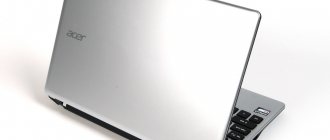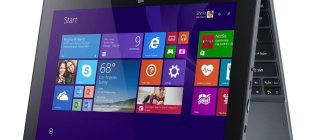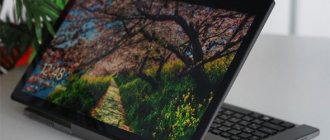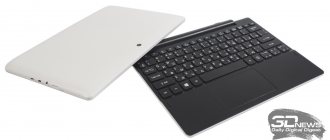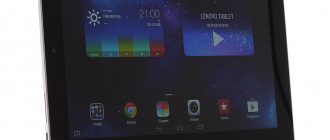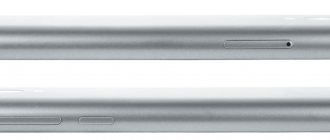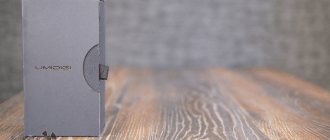Processor is a significant advantage
In our list of laptops under 40,000 rubles, Acer Aspire 3 is unique. While other manufacturers rely on low-cost Pentium processors or legacy processors, the Aspire 3 uses the cutting-edge Intel Core i3-8130U with Lake Kaby architecture. Thanks to turbo mode, processor frequencies can rise under load from 2.2 to 3.4 GHz, which brings its performance closer to the previous generation of Intel Core i5 processors. It's no surprise that the Acer Aspire 3 sets new standards in terms of performance - especially when the powerful processor is paired with a 256GB SSD and 4GB of RAM.
Thus, the laptop offers more than enough power for everyday office and Internet tasks. Even graphically not very complex games such as Fortnite: Battle Royale can be easily run on this device. The laptop always remains virtually silent. But more resource-intensive image and video processing will slow down on it due to limited RAM. Although this is already par for the course among devices in this price range.
Office, multimedia, games: Intel Core i3-8130U can handle almost any information
⇡#Technical characteristics
| Acer Aspire S 3 | |
| CPU | Intel Core i5-2467M: 1.6 GHz (up to 2.3 GHz with Turbo Boost); 2x256 KB L2; 3 MB L3; two computing cores |
| Chipset | Intel UM67 |
| Graphics controller | Intel HD 3000, integrated into the processor |
| Screen | 13.3 inches, 1366x768; Glossy finish, LED backlight (AU Optronics B133XTF01.0) |
| RAM | 4 GB, DDR3-1333 (soldered on the motherboard, Elpida) |
| HDD | Two drives: 20 GB SSD (used for sleep mode only) 320 GB HDD SATA Rev. 2, 5400 rpm, thickness 7 mm (Hitachi HTS543232A7A) |
| Optical drive | Absent |
| Flash card connector | SD/MMC |
| Interfaces | 2 x USB 2.0 1 x HDMI 1 x combined audio jack (mini-jack 3.5 mm) |
| WiFi | 802.11b/g/n (Atheros AR5B225) |
| Bluetooth | 4.0 (Atheros) |
| Network adapter | — |
| Sound | Realtek ALC269; two speakers, microphone |
| Nutrition | Battery of 3 flat cells, 36.4 Wh (3280 mAh, 11.1 V) Power supply 65 W (19 V; 3.95 A) |
| Other | Metal body and cover, webcam |
| Size, mm | 323x219x13-17.5 |
| Weight, kg | 1,36 |
| operating system | Windows 7 Home Premium SP1 (64 bit)* |
| Official manufacturer's warranty | 12 months |
| recommended price | From 31,990 rub. |
The tested Aspire S3 configuration had one of Intel's low-end ULV processors installed - Core i5-2467M. Unlike the i5-2537M model, which we met when testing the Samsung 900X3A, this CPU has a slightly higher nominal frequency - 1.6 GHz versus 1.4. However, the TurboBoost mode settings are less aggressive, so this processor can dynamically accelerate to approximately the same frequency values - 2.1 GHz when both cores are loaded and 2.3 when only one of them is loaded. For the Core i5-2537M, the corresponding values are 2.0 and 2.3 GHz. So the processors are, in general, almost the same.
This CPU has support for the AES-NI instruction set, which speeds up encryption. The only thing it lacks is support for Trusted Execution Technology (TXT) and Intel Virtualization Technology for Directed I/O (VT-d). Otherwise, this is a completely full-fledged Core i5 with all the advantages of this family of processors.
The memory capacity in any Acer Aspire S3 configuration is 4 GB and cannot be increased by any means. For the simple reason that the memory chips in this model are soldered directly to the motherboard, and there are no connectors for installing a standard (or at least non-standard) RAM module in the Aspire S3.
The Acer Aspire S3 uses the UM67 southbridge - the letter U in its name obviously hints at ultra-mobility. In terms of basic characteristics, this chip is almost completely similar to the advanced south bridge HM67. The only difference is that the TDP value is reduced from 3.9 to 3.4 W. This is not such a small saving as it might seem at first glance. For example, it roughly corresponds to the difference between the nominal power consumption of 11- and 13-inch LCD displays.
There is no external graphics system for the Aspire S3 - the user will have to be content with an exclusively integrated Intel HD 3000 adapter, which in this case operates at a standard frequency of 350 MHz with the ability to dynamically increase it to 1150 MHz. By the way, in this regard, the Core i5-2467M looks more interesting than the Core i5-2537M - in the latter, the frequency ceiling for the integrated graphics core is 900 MHz.
The list of configurations available in Russia and recommended retail prices at the start of sales is as follows:
| Configuration | CPU | Storage device | price, rub. |
| S3-951-2634G24iss | Core i7-2637M (1.7-2.8 GHz) | SSD 240 GB | 54 990 |
| S3-951-2464G24iss | Core i5-2467M (1.6-2.3 GHz) | SSD 240 GB | 46 990 |
| S3-951-2634G52iss | Core i7-2637M (1.7-2.8 GHz) | HDD 500 GB | 40 990 |
| S3-951-2464G34iss | Core i5-2467M (1.6-2.3 GHz) | HDD 320 GB | 31 990 |
The price for the low-end configuration of the Aspire S3 - the same one discussed in this review - looks extremely tasty. Apparently, the main sales will come from it. More advanced versions are downright expensive. Most likely, the recommended prices will not be observed for such configurations. You can expect with a high degree of confidence that in practice older Aspire S3s can be purchased much cheaper. Because it’s hard to imagine a person who would overpay almost twice for a device whose only significant competitive advantage - let’s call a spade a spade - is its affordable price.
How does a laptop work?
Since the laptop case is metal, the designers were not able to use latches in this case. The housing halves are attached only with screws. What’s nice is that with a regular Phillips slot, there are no non-standard mockeries like a pentagonal star, as in the MacBook Air. In general, you can disassemble a laptop in literally a couple of tens of seconds, which we, of course, did.
The first thing you can do is make sure that the lower part of the case is made of magnesium alloy. Unfortunately, it’s almost invisible in the photo, but on the bottom there is the marking AZ91D - this is the most popular brand of Mg alloy among laptop manufacturers.
At the same time, here you can see the reverse side of the shiny plate on the bottom. It turns out that this part covers the hard drive. Although the hard drive is thin, in a 7 mm case, it still doesn’t quite fit in thickness - I had to make a cutout in the thick magnesium bottom and cover it with a thin (steel?) plate.
The upper half of the case is also made of magnesium alloy. All the filling is mounted on it. Unfortunately, the wiring of the Wi-Fi antenna prevents the halves from being completely separated - it is fixed on a plastic insert transparent to radio waves, which, in turn, for some reason is glued to the bottom - although nothing seemed to prevent it from attaching it to the top of the case, making the structure completely collapsible.
The computer itself takes up barely 20% of the volume of the case. Everything else is additional devices. First of all, the battery. It is put together rather stupidly. It takes up a lot of space, and it only has three batteries. There is quite a lot of emptiness inside the Aspire S3, caused by too thin areas of the body. In general, the designers of the Aspire S3 still have potential to improve the layout. Obviously, they will be able to exhaust it somewhere by model S3.3.
As already mentioned, the memory is soldered directly onto the motherboard. As well as the processor, by the way. Proofpick:
The disk system takes up about the same amount of space as the main part of the motherboard. Most of the space, of course, goes under the hard drive.
The 20 GB solid-state drive, like the memory and processor, is soldered directly to the motherboard.
This SSD is not intended for storing programs or user data. He is solely responsible for the implementation of “fast sleep” technology – Intel Rapid Start. In a nutshell, the point is that the laptop can go into a non-volatile (to be precise, energy-almost non-dependent) sleep and immediately return from it. Accordingly, SSD is used to store the memory contents.
In fact, Rapid Start mode is not a sleep mode. But not exactly hibernation. Rather, it is a kind of hybrid between these two states, combining the advantages of both modes. However, in the operating system this is called “Sleep,” which is more user-friendly.
And from an interface point of view, it works like a dream. This happens as follows. First, the laptop goes into normal sleep: it doesn’t turn off completely, lazily blinks with the “I’m not turned off, I’m sleeping” indicator and is woken up from the sleep state by any button. Or by opening the lid, if he was put to sleep by simply slamming it shut. However, after a while - in the settings you can set the values 120 and 480 minutes, as they say, without regaining consciousness, the laptop independently carries out the process of quasi-hibernation and goes into “deep sleep”.
It is brought out of “deep sleep” only by pressing the power button. However, and this is the most important difference from classic hibernation, the system does not fully boot. The laptop wakes up almost instantly. It feels like Intel Rapid Start is faster than the same feature on the MacBook Air. Although we didn’t test it with a stopwatch, so we won’t swear on the Bible about it.
Weakness #1: Hardware and ergonomics
While the processor spares no effort, the device is disappointing in other ways. The Aspire 3 only has one USB 3.0 port and two slow USB 2.0 ports. You won't find the latest Type-C port on the laptop. The rest of the equipment is excellent, including support for WLAN-ac and Bluetooth 4.0 wireless modules. Otherwise, there are no surprises: there is an HDMI port, an SDXC memory card slot and a LAN port.
The Chiclet keyboard is not backlit and challenges even experienced typists, as the slippery surface of the keys makes the fingers slide a lot, and the keys themselves are very flat. But with all this, a touchpad that is not too sticky or slippery can be considered a good alternative to a mouse. It was he who added points to the device when assessing the ergonomics of the device.
Thanks to the optional service cover on the bottom of the laptop, the device can be upgraded by adding a 2.5-inch hard drive
Appearance and ergonomics
Acer Aspire 3 A317-51G belongs to the budget category of laptops, the price for the minimum configuration is 41 thousand rubles. Therefore, as expected, the body of the device is entirely made of black matte plastic, which is quite susceptible to fingerprints. We have no complaints about the build quality, and the same goes for the strength of the case. The dimensions of the device are quite large - 419.5x289.5x25 mm, weight 2.8 kg. The Acer Aspire 3 A317-51G has a standard set of sweats. Left side: Gigabit Ethernet, HDMI, USB 2.0(Type-A), USB 3.2 Gen 1(Type-A), combo audio jack. Right side: USB 2.0 (Type-A), optical drive, security lock slot. Unfortunately, there is no card reader, but there is a device for reading CDs; by the way, an optical drive is practically not found in laptops these days, since very few people need these devices.
Approximately one fourth of the bottom is occupied by ventilation system grilles. Also on the bottom panel there are three support legs - two small and one long.
| Height | Weight | |
| HP 470 G7 | 24.5 mm | 2.40 kg |
| Acer Aspire 3 A317-51G | 24.6 mm | 2.80 kg |
| Lenovo Ideapad L340-17API | 24.3 mm | 2.80 kg |
| Asus VivoBook 17 F712FA | 21.4 mm | 2.30 kg |
Input Devices
The Aspire A317 has a full-size island-type keyboard without backlight. Flat, slightly rough keys provide short travel and a clear pressure point. The distance between the keys is sufficient to avoid accidental presses. The arrow block (up/down buttons) is narrowed vertically like all Acer A series laptops. Otherwise, the keyboard is quite comfortable to work with. The touch pad has dimensions of 10.6 x 7.8 cm. The smooth surface of the touch pad allows your fingers to slide easily on the panel. Overall, the touch pad has a short stroke and a clear pressure point.
Display and sound
The matte 17.3-inch display has a resolution of 1920x1080 pixels, the matrix provides a good contrast ratio of 1535:1, but the maximum brightness of 258.1 cd/m2 is too low. The display shows very decent color reproduction, the matrix does not suffer from blue tints, and shades of gray are displayed as expected. AdobeRGB color space is 56.8% and sRGB is 86.7%. In general, the matrix shows good results for an inexpensive multimedia laptop. Two stereo speakers are responsible for sound output in the laptop; their maximum volume is high, but there is no bass.
Weak point #2: Display
The fact that Acer likes to save money on the display in its Aspire series is no longer news. The Taiwanese have never fallen as low as with the Aspire 3 A315-51 in our tests. Although the 15.6-inch TN display panel has a resolution of 1920 x 1080 pixels (Full HD), it offers a very narrow viewing angle and poor color saturation. In addition, the checkerboard contrast, that is, the simultaneous display of dark and light areas, is below average here - 147:1. Like its predecessor, the panel's brightness is quite low. The Aspire 3 achieves a maximum of 176 candelas per square meter - too low for outdoor use on sunny days.
Weakness #3: Mobility
The Acer Aspire 3 is only partially suitable for use on short trips or on the train. The battery lasts less than six hours of video playback. In pure office mode, the laptop can work for less than 7.5 hours, but as soon as the work becomes more resource-intensive, the laptop turns off after about 4 hours. The laptop weighs less than 1.8 kg - not that light, which is why the mobility rating is quite average. The best results are obtained when connected to the network and with an external monitor.
Although the Aspire 3 is relatively thin, it's only slightly suited for travel
Functionality
Acer Aspire V3 laptop will go on sale in two main modifications - a hybrid based on NVIDIA GeForce GT 630M/640M “Kepler” integrated into the processor and discrete graphics, or only with an integrated Intel HD Graphics 4000 solution. One of the widest possible range of solutions from Intel, starting with the budget Pentium B960 and ending with the most powerful quad-core Intel Core i7 “Ivy Bridge”.
You can see the characteristics of the model we visited (test sample) in the corresponding table; in this configuration, it scored 2650 points in PCmark7 and 3000 points in 3Dmark11.
The battery life of the Acer Aspire V3 was 1 hour 10 minutes in maximum load mode and almost 4 hours in read mode, which is quite good for a system with a powerful quad-core processor and discrete graphics.
The first deliveries of Acer Aspire V3 should arrive in Ukraine in early June; the cost of a basic configuration based on an Intel Core iX Ivy Bridge processor, 4 GB of RAM, 750 GB HDD and NVIDIA GeForce GT 630M graphics will be UAH 7,555.
Characteristics and test results of Acer Aspire 3 A315-51-336X (NX.GYYEV.007)
| Price-quality ratio | 54 |
| operating system | Windows 10 Home |
| Dimensions | 38.2 x 25.9 x 2.3 cm |
| Weight | 1.8 kg |
| CPU | Intel Core i3-8130U (2.2 GHz) |
| RAM capacity | 4 GB |
| Video card type | integrated into the processor (Intel UHD Graphics 620) |
| Video card model | — |
| Video memory capacity | — |
| Display: diagonal | 15.6 inches |
| Display: resolution | 1.920 x 1.080 pixels |
| Display: surface | glossy |
| Display: max. brightness | 176 cd/m² |
| Display: staggered contrast | 147 :1 |
| Display: Pixel Density | 141 dpi |
| Display: brightness distribution | 91,8 % |
| Storage capacity | 256 GB |
| Drive type | SSD |
| Optical drive | No |
| Battery: capacity | 37 Wh |
| Autonomous operation: office suite | 7:40 h:min |
| Autonomous operation: video playback | 5:46 h:min |
| Noise at mask. load | quiet |
| USB ports | 1 x USB 3.0, 2 x USB 2.0 |
| Bluetooth | Yes |
| WLAN | 802.11ac |
| LAN connector | 1 Gbit/s |
| UMTS | |
| Dock station | — |
| HDMI | HDMI |
| Other digital video outputs | — |
| Analog video outputs | — |
| Card reader | SDXC |
| Webcam | Yes |
| Optional equipment | — |
| Test: PCMark 7 | 5.129 points |
| Test: 3DMark (Cloud Gate) | 5.887 points |
Review of the Acer Aspire S3 ultrabook
The year just ended gave lovers of ultra-compact but powerful laptops a gift in the form of the concept of “ultrabooks.” Now, users who want to own a truly light and very thin portable computer do not have to look towards the MacBook Air. An alternative has appeared in the form of elegant Windows devices. And the first among them in the summer was the hero of our review - Acer S3. This solution is the flesh of an ultrabook: its thickness is 17 mm, its weight is 1.4 kg, and the processor here is quite powerful (Intel Core i5 2467M 1.6 GHz). Moreover, the Acer S3 is so far the only device presented on the Ukrainian market that fits into the price limit of up to $1,000 declared by the developers of the ultrabook concept.
Specifications Acer Aspire S3
- Operating system: Windows 7 Home Premium.
- Processor: Intel Core i5 2467M 1.6 GHz.
- Display: 13.3 inches, 1366x768 pixels, glossy.
- RAM: 4 GB.
- Hard drive: 320 GB + SSD 20 GB.
- Video adapter: Intel HD Graphics 3000.
- Communications: Wi-Fi 802.11 b/g/n, Bluetooth 4.0
- Battery: 3 cells, built-in, 3280 mAh, built-in. 36 Wh.
- Ports: 2xUSB 2.0, HDMI, 3.5 audio jack (headphones), card reader.
- Dimensions and weight: 323x218x13~17 mm, 1.4 kg.
- Camera: 1.3 MP.
Contents of delivery
There's nothing special in the box. In addition to the laptop itself, there was room for a compact power supply, a quick user manual and a ton of useful papers.
Appearance and ergonomics
I think that when looking at the Acer S3, without further ado, it becomes clear whose bright image stood before the eyes of the laptop design developers. So that there is no doubt about this, we invite readers to look at the photographs below.
Same rounded corners. Metal cover. Island type keyboard. Subtlety. However, we dare to assure readers that photographic similarity significantly exceeds similarity in real life. The quality of materials and workmanship is completely incomparable.
Thus, the Acer S3 body (except for the bottom and lid) is made of matte gray plastic. And the roughness of the keyboard edge and the under-palm space gives the impression that they were walked over with sandpaper. Practical, but very budget-friendly in feel and appearance. The metal lid looks a little more presentable. However, the sheet of metal is too thin, so it bends even under light pressure.
The hinges holding the two halves of the device together also did not seem to be the standard of quality: although they are tight, they are somehow uneven, as if poorly lubricated. It is problematic to open the laptop with one hand, unlike its “colleagues” produced by Asus and Apple.
The engineering geniuses who designed the laptop allowed the S3's lid to tilt at a very wide angle, but did not take care of stability. This has led to the fact that when fully open, the laptop lid overhangs slightly, transforming the device into a kind of “rocker”.
Comparison with MacBook Air: both laptops are opened to their maximum
But the bottom of the laptop, equipped with rubber feet, allows it not to slip on almost any surface. You can find 12 standard screws on it, that is, the device can be opened simply. Unfortunately, you cannot replenish your RAM reserves. You'll have to be content with the 4 GB that are tightly soldered into the board. On the bottom you can also see a hard drive covered with a special insert, and on the sides there are tiny speaker slits, strikingly reminiscent of those on smartphones.
The side edges of the S3 are somewhat convex and less wedge-shaped compared to the MacBook Air and, especially, the Asus Zenbook. In addition, unlike the “sides” of competitors, they are practically empty: on the left, closer to the screen, there was only room for a 3.5 mm mini-jack, on the right – for a card reader.
The remaining connectors are located on the rear edge, on the mount. The thin body made it possible to fit a little: a power connector, HDMI (that's what the MacBook lacks!) and two USB 2.0. Next to them you can also see a grille covering the heat removal system.
The island-type keyboard is made in dark gray, in harmony with the overall low-key tone of the laptop. Even the traditional (and it’s unclear who needs) Intel and Microsoft stickers, which in the laptop are not colorful, as usual, but gray and white, harmonize with it.
Screen and sound
The Acer Aspire S3 has a standard glossy TN matrix with a resolution of 1366x768 pixels. The resolution is lower than that of the 13-inch ASUS Zenbook UX31 (1600x900 pixels) and than that of the Apple MacBook Air with the same screen diagonal (1440x900 pixels). However, the cost of the models varies significantly. The contrast and color rendition of the display are quite consistent with the middle class. The screen is quite bright, but in this parameter it is inferior to its colleague installed in the Asus Zenbook. In the sun, even at maximum brightness, you will have to strain your eyes, although in general you can see the picture. Vertical viewing angles are quite small, but horizontal ones are quite enough for watching a movie in a small company. Although the laptop says that its sound system complies with the Dolby Home Theater standard, there is nothing good to say about the built-in speakers. Their poor location and small size result in a rather unpleasant sound. Maximum volume is medium. Of course, this sound is quite typical for ultrabooks. I know of only one exception to the rule: an ultra-thin laptop that sounds quite passable. Its name is MacBook Air.
Keyboard and touchpad
Most island keys are fairly large squares with rounded corners. Their movement is not the clearest: if you press a key too lightly, it does not work, you have to press harder. However, this feature is quite easy to adapt to. But I think only gnomes can come to terms with the arrow block: apparently, it was for them that these 6 tiny keys were made, which, together with the spaces, occupy the same area as the Shift button located under them. In a word, in order not to press anything unnecessary, you will have to strain with them. In addition, the home and end buttons cannot be used without pressing the function button, which is not very convenient. The shape of the Enter key is also puzzling. The creators' intention, which visually united her with her neighbor above (\), remains a mystery to me. Is this really necessary in order to get a contour analogue of the classic Enter key, only upside down?
Overall, typing comfort can be given an average rating. I liked the power off key, which is separate and located under the screen on the left, more than that of rivals, where it is hidden in a row of function keys. You won’t press this by accident and you won’t confuse it with anything. The touchpad here is quite large (albeit smaller than the Mac one), and smooth to the touch. It is slightly recessed into the body, and at a slight angle (the lower part is more recessed). The keys on it are not marked in any way and are not separated from the touchpad itself, however, it is quite convenient.
System and performance
The S3 is a standard modern laptop based on the Intel Sandy Bridge platform. At the time of testing, Acer offered its first ultrabook in variations with three different processors - Core i3-2367M, Core i5-2467M and Core i7-2637M. We got the middle option. A low-voltage processor with a frequency of 1.6 GHz and a thermal package of 17 watts is also used in the 11-inch MacBook Air 2011 and in one of the Asus Zenbook configurations.
Like other ultra-thin solutions, the Acer S3 does not have a discrete graphics card. Therefore, for graphics processing, the laptop is equipped only with a built-in Intel HD 3000, which will not satisfy every modern game. Tests confirm this. For example, in 3DMark Vantage the computer scored 1494 points, and the Resident Evil result was 15.8 fps, which is slightly higher than the achievements of the Asus Zenbook we tested earlier. Such results can be considered average for the class, just enough to play not the fastest games at half settings.
Resident Evil test results
The ultrabook did not receive the highest score in the PCMark7 test - 1876, although according to subjective feelings the device works quite quickly and copes well with “heavy” tasks, for example, playing HD movies.
True, the Asus Zenbook seemed faster to us, most likely not due to the processor (the tested model had a Core i7 2677M installed), but due to the use of an SSD. The more affordable S3 did not install an expensive high-capacity solid-state drive, being satisfied with a hybrid system of a regular 320 GB HDD and a 20 GB SSD. The latter retains the contents of RAM when entering sleep mode. This does not particularly affect the speed of operation, but the laptop “wakes up” almost instantly.
The S3 comes with a standard 4GB of RAM. Unfortunately, you won't be able to expand your memory. However, this is not particularly necessary. This is sufficient for running most programs (except for games) running Windows 7 Home Premium.
By the way, the laptop comes with a fairly large package of pre-installed applications. In particular - McAfee Internet Security (I don’t want to seem biased, but personally this program seems very intrusive to me in its desire to protect the user from Internet adversities, and makes me want to turn it off as soon as possible), the utopian application Fuz Kids (its utopianism lies in an attempt to create a safe Internet space for those who are still young), Acer Games (a store where you can try out toys for free and then buy them).
I found Acer's proprietary applications a little more useful, including recovery, backup and update tools, as well as a program for working with the built-in camera and a quite passable News xPresso news aggregator.
Autonomy, noise and heating
The heat in the laptop is exhausted on the left, and I must say, it doesn’t get too hot even under high loads, for example, when launching HD movies and running synthetic tests. The use of a low-voltage processor probably has an effect. The computer also makes little noise: you notice a slight hum only under maximum load. The model’s battery is non-removable and not the most capacious (3200 mAh), so we did not expect any great heights from the battery life. However, it turned out to be unimpressive, but sufficient for a thin device: with minimal load, the S3 lasted 6 hours 28 minutes, with average load (surfing with medium screen brightness) - about 4 hours.
Competitive environment
The first ultrabook competes with all other ultrabooks, of which there are not so many today. This is the Asus Zenbook family and, of course, the forerunner of the thinnest ones - the Apple Macbook Air. The latter has excellent design, thoughtful ergonomics and high-quality assembly.
Together with 13-inch MacBook Air
Whether the OS should be considered an advantage is a controversial issue for many. But what is indisputable is the fact that the cost of Apple laptops has never been affordable, while the Acer S3 is more attractive in this regard. Including compared to its other competitor, Asus Zenbook.
Together with the 11-inch Asus Zenbook
Together with the 11-inch Asus Zenbook
The 13-inch Asus model has a better resolution matrix, and the body materials seem to be of higher quality. But the difference in price may be a completely adequate reason to choose the Acer S3.
Bottom line
The first ultrabook fully lives up to its name. It is thin, light and quite productive. It is absolutely enough for watching movies, surfing the Internet and office tasks, including image processing. However, ultra-thinness comes at a price. And not only in hard cash, but also in certain inconveniences. Thus, the few connectors on the Acer Aspire S3 are not located in the best way, the battery is non-removable and not the most capacious, the keyboard has an unclear movement and some tightness (though only in places). In terms of presentation, the hero of our review is quite far from the Apple MacBook Air and even the Asus Zenbook. But today the Acer S3 is the most affordable ultrabook. And this is with performance comparable to the others. Four reasons to buy the Acer S3:
- Thin and light body;
- Low starting price;
- Decent performance;
- Good cooling system.
Three reasons not to buy an Acer S3:
- Not the best build quality;
- Poor placement of connectors;
- Not the best tactile feedback of the keys.
Acer Spin 3 SP314-51-P0WG 2in1 Touch (NX.GUWEV.007)
That Acer can also produce balanced laptops is proven by the Acer Spin 3 SP314-51 with a rotating 14-inch touchscreen display. It has excellent ergonomics and long battery life.
Although its performance is not at the level of the Aspire 3, it is sufficient for everyday tasks. In terms of price, this model is slightly more expensive than our test subject - about 35,000 rubles.
HP 250 G6 SP (2UB93ES #ABD)
Although the HP 250 G6 is slower than the Acer Aspire 3, it is well equipped. First of all, it has 8 GB of RAM and a fast 128 GB SSD.
It also has a DVD drive and plenty of ports. The display and battery life are virtually identical to the Acer device. True, the HP 250 G6 costs about 5,000 rubles more.

